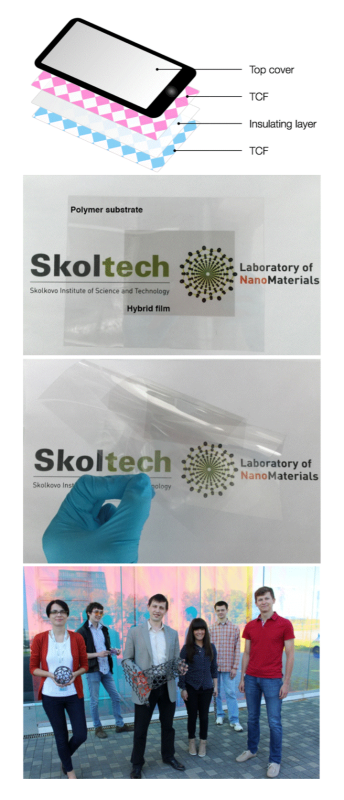
a) Structure of a capacitive touch screen; b) CNT/graphene hybrids are inherently flexible and can be deposited on flexible substrates such as PET; c) members of Skoltech Laboratory of Nanomaterials
A group of researchers led by Skoltech professor Albert Nasibulin has recently reported developing a novel carbon nanomaterial that can be used as a transparent conductor in modern electronic devices. The results of the study have been recently published in Carbon, a prestigious journal dedicated to the scientific advances in the field of carbon materials and carbon nanomaterials.
Transparent conductive films (TCFs) are widely used in modern electronic devices such as organic light emitting diodes (OLEDs), liquid crystal displays (LCDs), touch screens and solar cells. Today’s industry standard transparent conductive films are based on rare metal oxides, such as indium-tin oxide (ITO), which are scarce and are therefore becoming increasingly expensive. Various materials were proposed as potential replacements for ITO. Among them, carbon nanomaterials (carbon nanotubes (CNTs) and graphene) are showing the biggest potential due to their extraordinary electrical, optical and mechanical properties. However, the optoelectrical performance of CNT- or graphene-only TCFs has still not reached the optoelectrical performance of ITO. One of the ways to further improve optoelectrical characteristics of CNT- and graphene-based TCF is hybridization of these two materials. This approach leads to creation of novel materials that exhibit better properties than the separate constituents do. Researchers from Skoltech Laboratory of Nanomaterials have developed a novel hybrid CNT-graphene nanomaterial for use in TCFs that can potentially replace ITO in electronic devices.
Skoltech PhD students Alexandra Gorkina, Evgenia Gilshteyn and Alexey Tsapenko fabricated CNT/graphene hybrids and performed their optoelectrical characterization. Hybrids were prepared by a facile and low-cost method, which included spray deposition of graphene oxide (GO) onto CNT films, GO reduction in ambient or reducing atmosphere, and, finally, chemical doping of the samples with gold (III) chloride.
Results of the study show that the hybrids demonstrate excellent optoelectrical characteristics, with sheet resistance as low as 73 Ω/□ at 90% transmittance. Compared with optoelectrical performance of CNT/graphene hybrids reported in literature, the samples produced by Skoltech researchers show superior performance.
Reference:
Gorkina, A. L.; Tsapenko, A. P.; Gilshteyn, E. P.; Koltsova, T. S.; Larionova, T. V.; Talyzin, A.; Anisimov, A. S.; Anoshkin, I. V.; Kauppinen, E. I.; Tolochko, O. V.; Nasibulin, A. G. Transparent and conductive hybrid graphene/carbon nanotube films. Carbon 2016, 100, 501-507.
Contact information:
Skoltech Communications
+7 (495) 280 14 81
